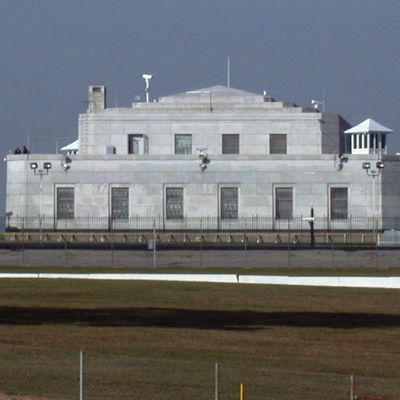
As America’s opinion-shaping elite continue debating the debt-ceiling end-around of minting a trillion-dollar platinum coin, we’ve begun to wonder about the logistics of protecting an object of such unprecedented value. Where would we store it? How would we prevent it from being stolen by Mr. Burns? For answers, we called up former Chief of the U.S. Mint Police Bill Daddio (yes, Daddio is his real name), who, for 27 years, until he retired in 2007, was “responsible for directing all protection programs and law enforcement functions for all the U.S. Mints facilities located in Washington, D.C.; Philadelphia, PA; West Point, NY; Denver, CO; San Francisco, CA and the U.S. Bullion Depository at Fort Knox, KY,” according to his bio page at Georgetown University, where he now teaches in the sociology department.
I get the sense you’re not a fan of the trillion-dollar platinum coin idea.
No, it doesn’t matter to me. [Laughs.] I’m a security guy, and so we just guard it. We don’t have, really, opinions. It’s just another thing to protect.
So where would we put this thing? Fort Knox?
Well, technically, what happens if you did make it — we would monetize it by transferring it to the Fed, and they’d give us a trillion dollars. That’s technically what happens. So theoretically, the Fed would have the coin. If they have it, they’d probably put it in New York, where they have their gold vaults.
Under the Federal Reserve.
Yeah, right. And they have some gold for us, actually. But they house gold bullion for many different countries, and that’s downstairs, right. And that’s where I’d put it if I were them. But if I were really them, I would transfer it to us and we’d store it in Fort Knox.
Because Fort Knox is more secure than the Fed?
Well, yeah. You’re looking at the most secure place in the world — at least, I spent my career trying to make it that way. [Laughs.] We just went through this some years ago with a rare 1933 gold coin. We control Fort Knox on the security side; it’s a very secure environment in its own right, both physically and environmentally. Platinum and gold are almost impervious to any oxidation or anything, so that’s not really a problem. But the isolation of it, and the lack of people going in and out of it, makes it more secure. Now, the downside of that is if you want to display it, you need to move it. And it’s not too expensive, but it’s not cheap. And something like that we’d probably move, like we normally do, with a small army. [Laughs.] We were in the business, when I was working there, of kind of taking things you can’t lose, for the government. So if you can’t lose it or you can’t get insurance on it, they come and see us, and we’ll move it for you, or protect it for you. We weren’t cheap, though. That takes a bit of expense in order to do it properly. So if it was me and I was advising the Fed, I’d transfer not title but custody of it back to the Mint and store it at Fort Knox.
So let’s say it’s in Fort Knox. Do you just throw in a room with all the gold, or do you take any special precautions because it’s such a single, valuable piece?
Well the nice thing about Fort Knox is that anything in there gets the same protections. We routinely store items for other government agencies, and there are separate compartments. Gold itself is segregated into different compartments. Something like [the trillion-dollar coin] would be segregated into its own compartment, which would be controlled by the auditors. The security guys have control over the facility, but the sub-compartments are controlled by the auditors, so neither one has total access to it.
So the trillion-dollar coin would have its own compartment?
Probably.
And is that a big safe or … you know, give me an idea of what that compartment is like.
About the size of a big walk-in closet.
Would there be lasers involved?
Well, that — we can’t get into that. [Editor’s note: Definitely so many lasers.]
[Disappointed laugh.] Okay.
We don’t talk about the specific security devices, which is one of the reasons why it’s so secure! To be honest, in major secure facilities, whether they be depositories, private or public, normally the only ability to steal something is with the help of an insider. So there are some places that are set up to control insider theft, and that’s kind of why Fort Knox would be more secure. But the Fed has very good security also.
I guess the special concern with a single trillion-dollar coin is that — unlike, say, a bar of gold — someone could just slip it into their pocket. Are there any extra precautions you’d have to take to prevent that?
Well, without getting into the details of it, I could tell you what we did for the 1933 coin, which would be a problem relative in size: It doesn’t travel as a coin. It stays in a container. And the container itself is small enough to carry, but certainly not small enough to put in your pocket. That’s kind of how we protect it. So once you put it in the container, it kind of moves in the container. And probably we’d keep it in a container even at Fort Knox. I remember when I was in the military, the keys in the orderly room were on a long stick, like a broomstick. And I said to the sergeant, how come you do that, and he said, “So nobody can put it in their pocket.” That’s kind of how you do security [for a trillion-dollar coin] also.
Has anything ever gone missing in Fort Knox?
Nope.





























